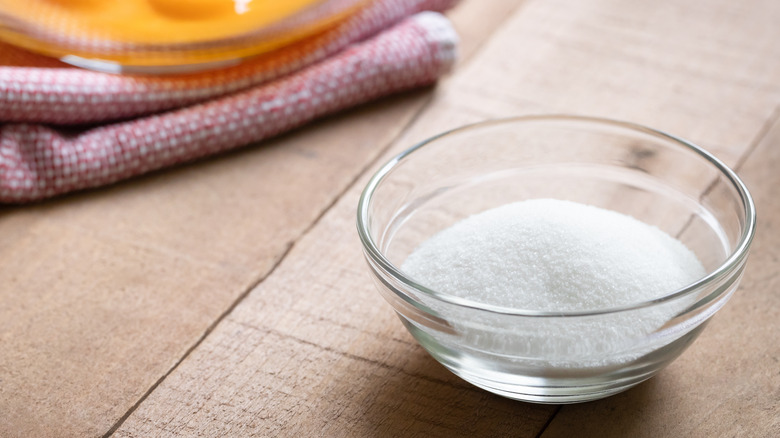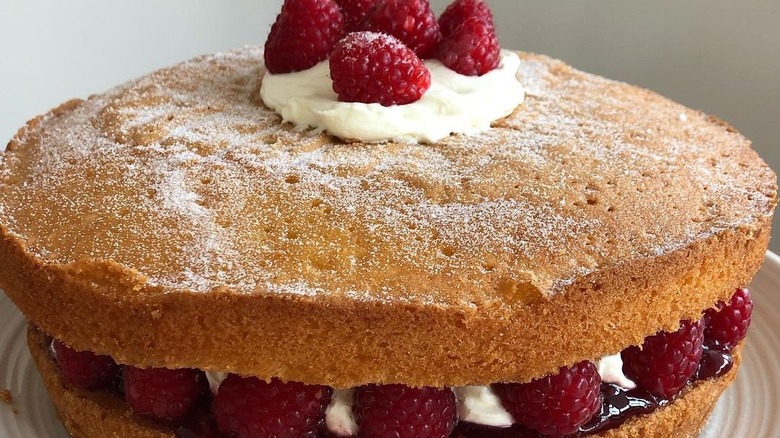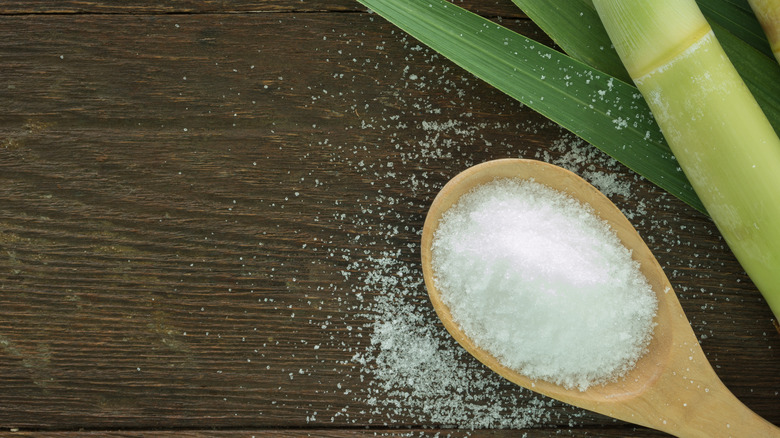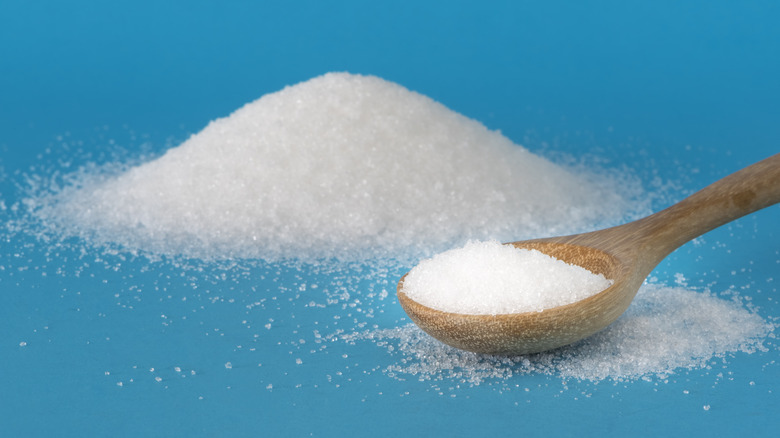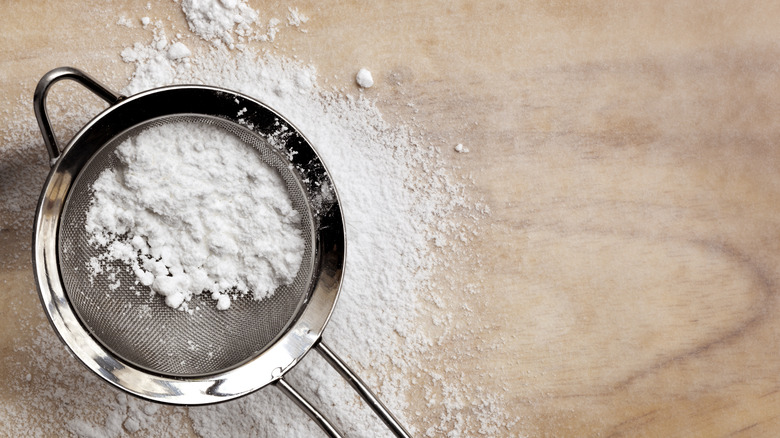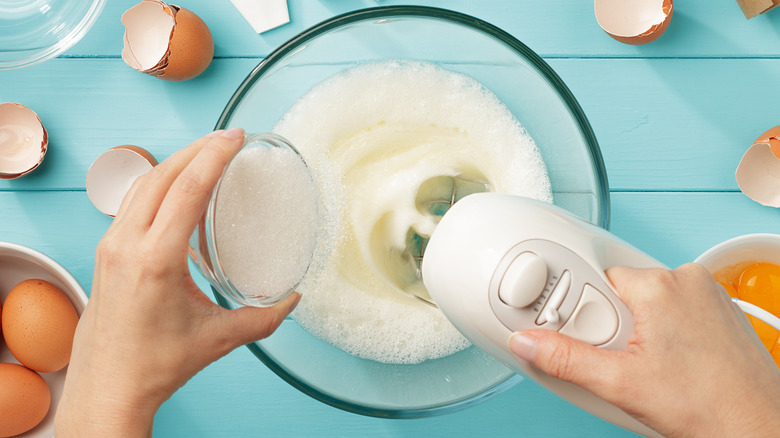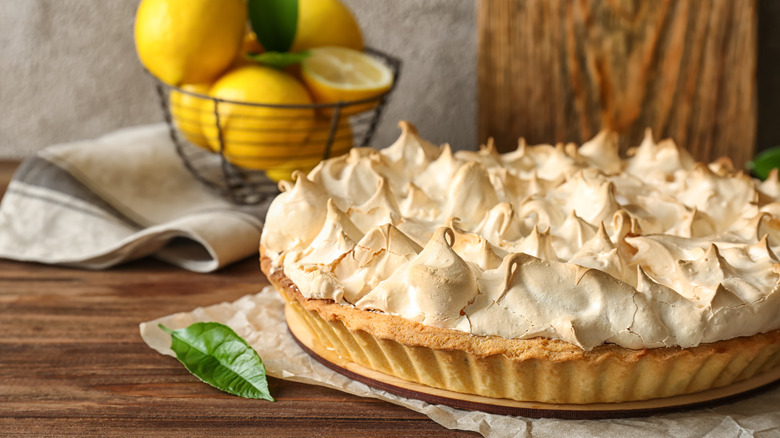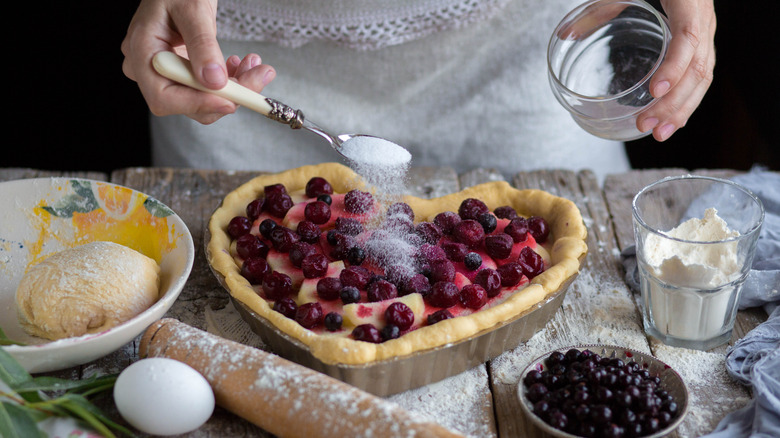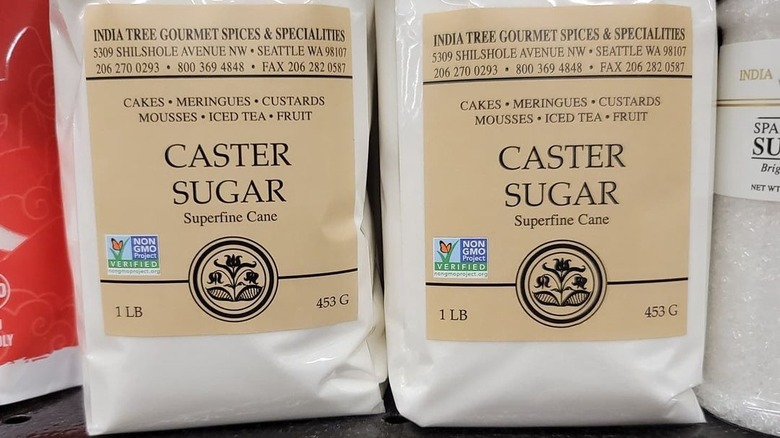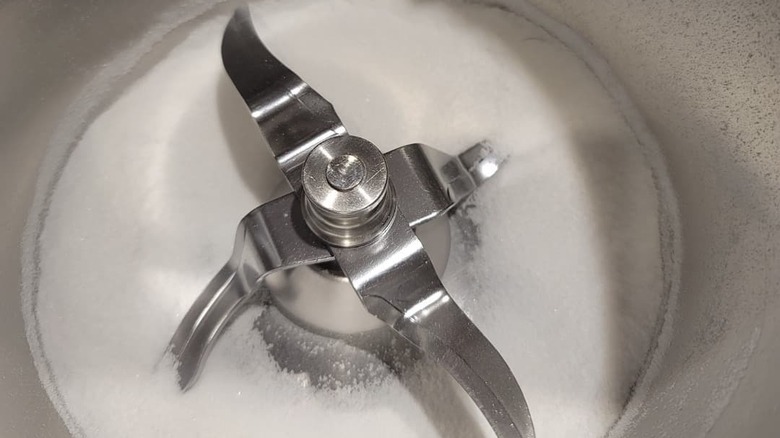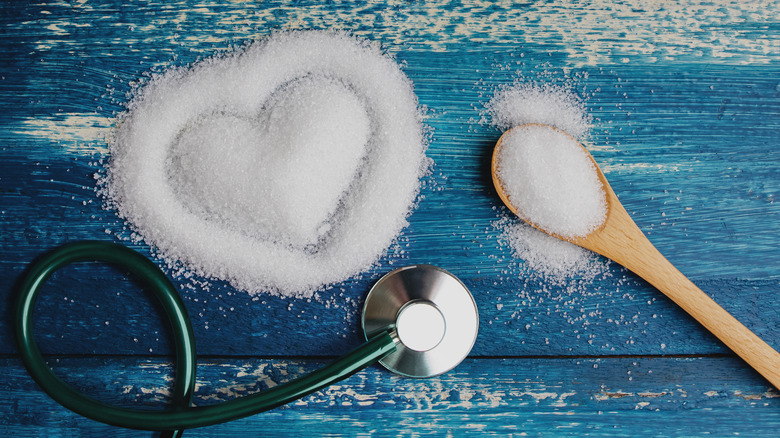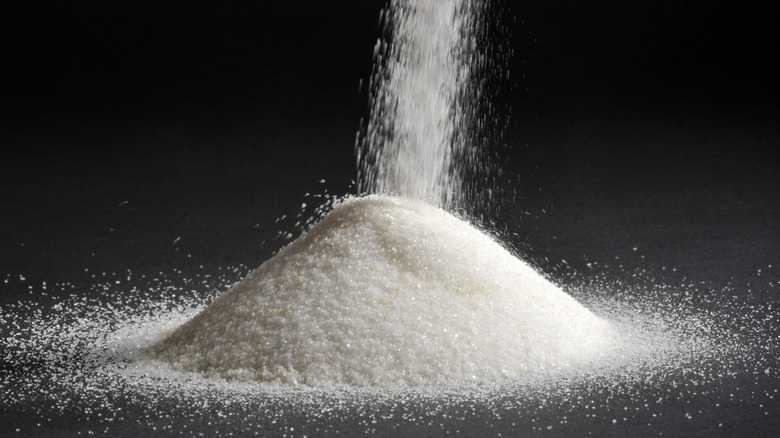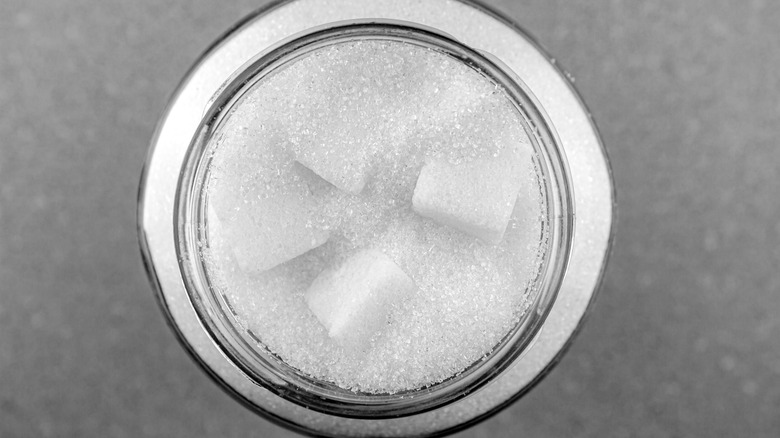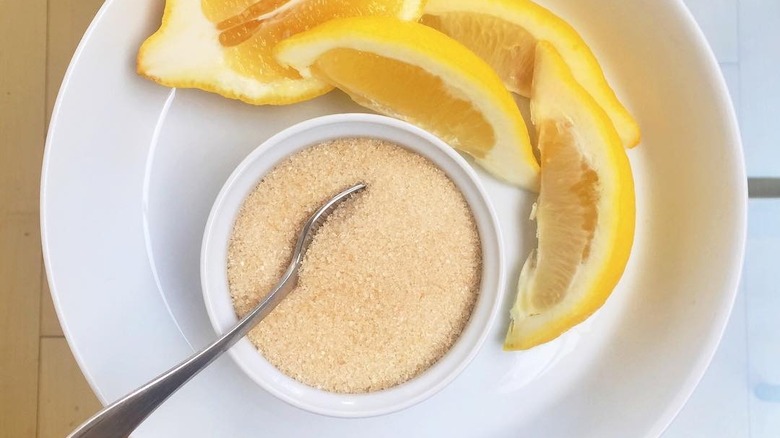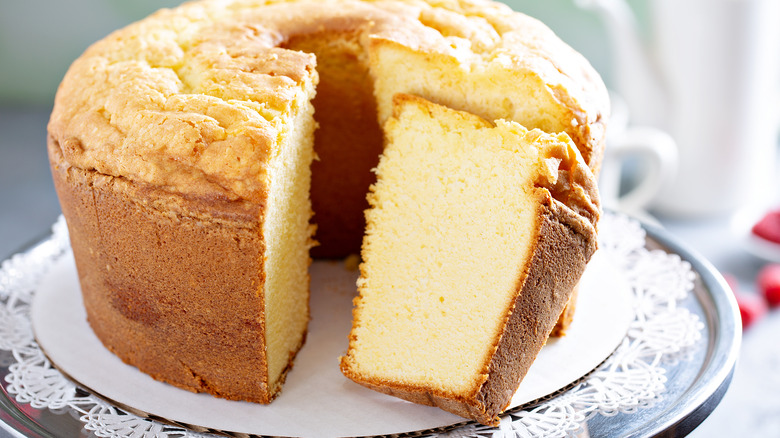What Is Caster Sugar And What's The Best Substitute For It?
We may receive a commission on purchases made from links.
Whether you've been moved to google "What is caster sugar?" after perusing a British or Australian baking recipe (or perhaps after watching an episode of "The Great British Baking Show"), or this is the first time you're hearing of the sweet stuff, we're about to clear up all your confusion.
Anyone who bakes even occasionally is likely familiar with many different types of sugar already, from pantry staples like brown sugar and powdered sugar to less common contenders like coconut sugar and pearl sugar — but caster sugar remains fairly obscure in the U.S. Chances are good, though, that you've seen it at the store before by another name!
Read on to find out what exactly caster sugar is, what it's called in the U.S., and whether you really need to buy it if you already have granulated sugar in the pantry. Plus, we'll detail how best to use caster sugar, why it's called that, and even how you can make your own caster sugar in a pinch.
What is caster sugar?
Caster sugar, also sometimes spelled castor sugar, is refined white sugar with especially small granules that is often used in baked goods, drinks, and desserts like mousse and custard, and is strongly preferred for meringues. Because caster sugar granules are so small and fine, they dissolve more easily than regular granulated sugar in liquids and when creaming with butter — but that doesn't mean it's always the ideal choice.
As for why it's called caster sugar, common wisdom is that its quick-dissolving, tiny grains were preferred for pouring into shakers (or casters) for sprinkling over berries and other fruit at the table. Very "Downton Abbey," no?
In America, caster sugar is often labeled as superfine sugar, ultrafine sugar, or baker's sugar. In some instances, you may also see it referred to as bar sugar, since many mixologists prefer it for cocktails. In Canada, caster sugar is sometimes sold as berry sugar. You can substitute all of these for each other at a 1:1 ratio.
How is caster sugar made?
Granulated sugar, of which caster sugar is one type, can be made from sugarcane or sugar beets, but the manufacturing process is much the same in either case. A liquid — either extracted sugarcane juice or boiled-down beet sugar — is purified, filtered, and crystallized into large, damp, brown grains that are then further refined.
Unlike comparatively minimally processed raw sugar, white sugar goes through a few more steps before being packaged, the last of which is milling into the desired size. As Michigan State University describes, any sort of processed sugar is "ground into fine, regular and large crystals," it all depends on how the sugar is to be used in cooking. Large crystals include coarse sanding sugar, which you may have sprinkled on your Christmas cookies; regular crystals include good old granulated sugar, and fine crystals include caster sugar and powdered sugar.
In short, caster sugar is made by the same process as regular granulated sugar but milled into even smaller particles at the final step.
Caster sugar vs granulated sugar
As outlined above, caster sugar is the same as the granulated sugar most of us are used to stirring into tea and mixing into cookie dough, just refined into even smaller grains (hence the "superfine sugar" moniker so much more commonly used on U.S. packaging labels).
In his much-lauded culinary bible "On Food and Cooking: The Science and Lore of the Kitchen," Harold McGee specifies that "standard granulated table sugar" crystals measure 0.3 to 0.5 mm each, while caster sugar granules are 0.1 to 0.3 mm each. Generally, you can use one in place of the other, with some notable exceptions and special considerations to keep in mind; more on those below.
Powdered sugar or confectioners' sugar, by comparison, is not the same thing as caster sugar, nor is it an acceptable substitute for caster sugar. Case in point, not all sugar is created equal.
Caster sugar vs powdered sugar
Let's start by talking about what powdered sugar is and how you use it. For the home baker, powdered sugar, confectioner's sugar, and icing sugar are the same thing: ground sugar mixed with cornstarch. The cornstarch, coupled with powdered sugar's superfine texture — 0.01 to 0.1 mm per granule — means that powdered sugar dissolves well and doesn't clump. That's how you get those velvety frostings and melt-in-your-mouth cookies.
Caster sugar, by contrast, doesn't contain cornstarch, and while it is much finer than granulated sugar, it is not as fine as powdered sugar. If you want to make an icing or glaze with that traditional white sheen (such as for this gingerbread cake with cognac glaze recipe), you can't achieve that with caster sugar. Likewise, if you want to dust your food with sugar, powdered sugar will give you a snowy look that you just can't get with caster sugar. Caster sugar is preferable in foods such as meringues and cakes.
By the way, it's easy to make powdered sugar from granulated or caster sugar. You'll need a high-powered blender or a spice grinder to get the powder consistency you want. Use 1 tablespoon of cornstarch for every cup of granulated sugar. Blend this mixture for 30 seconds and you've got yourself homemade powdered sugar. Note that when we're talking about professional baking, powdered sugar and confectioner's sugar aren't always interchangeable — but when you're at the grocery store, you shouldn't worry.
What does caster sugar taste like?
Unsurprisingly, caster sugar tastes like regular white granulated sugar. However, because it is composed of finer crystals, it will measure a bit differently by volume, and you could end up with a sweeter-than-intended end product.
According to My Food Book, 1 cup of caster sugar weighs 225 grams, while 1 cup of granulated sugar weighs 220 grams. It's not a huge difference, but in baking, precision often matters, and your best bet is measuring by weight. As one astute home cook put it on Quora, "50 grams of sugar is 50 grams of sugar, no matter what form it is in."
That said, if you don't have a kitchen scale, you're generally safe to use a 1:1 ratio of granulated sugar in place of caster sugar without changing the taste of whatever you're making. However, since sugar also provides structure and moisture to many baked goods, using the proper amount is about more than just flavor.
How to cook with caster sugar
Caster sugar most often appears in baking and dessert recipes from the U.K. and Australia. Take Mary Berry's Victoria sponge cake recipe, where caster sugar is incorporated into the batter and sprinkled over the finished cake. Using granulated sugar could cause this classically delicate dessert to be denser and coarser.
Why is this the case? In "The Ultimate Guide to Sugars and Sweeteners," the authors describe how the superfine granules of caster sugar "offer more crystalline surfaces than granulated sugar and thus will introduce more air as you are creaming the butter (or shortening) and sugar," producing lighter and finer-textured end results.
Because the smaller grains of caster sugar dissolve more easily and completely, it's also the preferred type of sugar to use in smooth mousses, puddings, and custards, and airy, fragile meringues. One Mashed writer's mother recounted how "not a single pavlova worked" until she tried caster sugar. MasterClass mentions using caster sugar in homemade ice cream and sorbet as well.
For the same quick-dissolving reasons, caster sugar is a great choice for sweetening drinks from hot coffee to iced tea and cocktails. Sprinkling caster sugar on fresh berries or other cut fruit is still a smart move, and it makes an especially delicate, shimmery-sweet coating when you roll warm donut holes in it, or use it to make candied violets or sugared citrus peels for decorating desserts.
Can you use granulated sugar instead of caster sugar?
In most cases, yes, this will work just fine. This lemon pound cake recipe calls for caster sugar as "ideal" but notes granulated will work as well. Ditto this classic English Eton mess recipe.
However, consider the experiments of a side-by-side cookie comparison on Food52: using caster sugar as the cookie recipe called for resulted in a "softer, lighter, and more buttery" treat, but the same recipe with granulated sugar turned out a cookie that was "drier and denser" but still deemed delicious.
In recipes that call for creaming caster sugar with butter, if you're using granulated sugar instead, The Spruce Eats recommends using colder butter and creaming it with the sugar just a little longer than normal. This will help it mesh a little better before the butter warms. They also advise that, when beating egg whites with sugar, if you must use granulated instead of caster, "mix at a lower speed to allow the sugar more time to melt." Baker and author Helen Goh gave the same tip to Food52, and suggested checking the meringue by touch; it's ready when "you can barely feel the sugar granules between your thumb and forefinger." If the larger granulated sugar crystals aren't fully dissolved, you may get telltale speckles and a less airy texture in your meringue.
Similarly, if you use granulated sugar in a cocktail that calls for superfine bar sugar, you'll need to shake or stir it a little longer.
Can you substitute caster sugar for granulated sugar in your usual recipes?
Conversely, if your regular cookie or pie dough recipe calls for plain old granulated sugar, is there any benefit to swapping in finer caster sugar instead?
It depends, but in general, not really. Recipes from cookbooks, established culinary sites, and the majority of big-name food blogs have been tested to be as close to perfect as they can be. So if the recipe calls for a specific type of sugar, that's what you should use. If you really want to, you can use caster sugar in place of granulated sugar in pretty much any application without detriment, but there's rarely any point. As Food Network notes, even Mary Berry opts for granulated sugar sometimes.
Since caster sugar is finer and dissolves more quickly, using it in place of granulated sugar while still creaming butter or beating eggs for the same amount of time the recipe calls for could alter the structure and texture of your dessert. So when granulated sugar is in the ingredients list and you're worried about potentially gritty results, your best bet is to follow your recipe and learn how to tell when butter is softened properly, and how to cream butter and sugar the right way.
Where to buy caster sugar
You should be able to find caster sugar in the baking section of any well-stocked supermarket, though in the U.S. it will likely be labeled superfine sugar or baker's sugar. As with most things in the world, you can also buy caster sugar online, from sites including Amazon, Sur La Table, and King Arthur Flour.
One thing you'll notice is that caster sugar tends to cost a little more than regular granulated sugar, which is probably because it does require a bit more processing. We compared the same brands and package sizes of granulated sugar and caster sugar at three different stores and found that, on average, caster sugar was $0.58 more per pound — although some specialty brands of caster sugar, like India Tree and Judee's, were significantly more expensive. This was especially noticeable when sold in smaller packages (as is often the norm with food prices, when buying a larger bag or box usually means paying less money per ounce).
The higher price is another good reason not to use caster sugar in places where regular granulated sugar will do the job!
How to make caster sugar
If you like to DIY, you can grind granulated sugar in a food processor, blender, coffee grinder, or spice mill to make your own caster sugar. When using a larger piece of equipment like a blender or food processor, Instructables suggests working in ½ cup increments, as smaller amounts of sugar won't be enough to make proper contact with the blades, and larger amounts could yield uneven consistency. Bob's Red Mill recommends starting with a little extra granulated sugar as some may be processed to oblivion.
If you use a grinder that's previously milled coffee or spices, be sure to clean and dry it well.
Then, all you have to do is give it a few pulses or whirls until your sugar has the texture of fine, silky sand. Depending on your specific equipment, this could take a few seconds, or more like 1-2 minutes. Keep checking periodically — and watch out for sugar dust — because if you process it too long, you'll end up with something more like homemade powdered sugar.
Because your homemade caster sugar will not be as uniform as store-bought, this won't be a perfect solution for all use cases (especially, per Bob's Red Mill, "with meringues and soufflés"), but it'll do in a pinch. Sift your DIY caster sugar through a fine-mesh sieve to filter out any coarser particles and store any extra in an air-tight jar or container.
Nutritional information about caster sugar
According to My Fitness Pal, 1 teaspoon of caster sugar contains 18 calories and 4 grams of carbs, whereas 1 teaspoon of regular granulated sugar contains 16 calories and 4 grams of carbs. However, when we looked at the nutritional information on the packaging of a couple of different brands of caster sugar and granulated sugar, the stats were exactly the same for both types of sugar in all cases: 15 calories and 4 grams of carbs per teaspoon.
The bottom line is, we all know eating too much sugar is not a good thing (especially when we're talking about refined sugar and added sugar) — but the nutritional difference between caster sugar and granulated sugar is fairly negligible, so one is not "better" or "worse" than another in terms of nutritional benefits or drawbacks. Long story short, it's best to enjoy either one in moderation.
How to store caster sugar
Storing caster sugar isn't too difficult. You can keep your caster sugar fresh the same way you would regular dry, granulated sugar. According to Utah State University, you ought to keep it in an air-tight, moisture-proof container, in a cool, dry place. Whatever you do, don't put your caster sugar in the fridge. That's because it can easily absorb odor and moisture there.
What kind of container do you need to store your caster sugar? For starters, if your sugar comes in paper or cardboard, it's best to transfer your sugar to something better for long-term storage — unless you're going to finish it right away! Your new container shouldn't allow moisture or odors to sneak through it. Some good options include food-safe plastic bags or buckets and glass jars. You can also use mylar bags or metal cans. Utah State University also recommends you don't eliminate all the oxygen from the container.
How long is caster sugar good for?
Technically, caster sugar doesn't go bad. Sugar, especially the dry varieties, isn't susceptible to microbial growth, so it won't spoil in the traditional sense (via Utah State University). That being said, sugar is best used within two years and some people say caster sugar is best within 18 months.
Over time, sugar loses its quality and gets hard or lumpy — that's because no matter how hard you try, eventually, moisture will make its way into your container. If you do find yourself with lumpy caster sugar, you can try to remedy it by running your sugar through the food processor. Food waste is a big problem these days, and this hack is a great way to stop throwing out expired food.
The fact that sugar doesn't really expire makes it pretty special. Some other foods that surprisingly never expire include honey, salt, and soy sauce.
What is golden caster sugar?
To complicate things a little more, there are actually two kinds of caster sugar: regular white caster sugar and golden caster sugar, which is unrefined (though the more accurate description would be "less refined" than white caster sugar, which has all its molasses removed).
BBC Good Food notes that golden caster sugar is known for having greater caramel undertones than regular caster sugar. Nigella Lawson's site describes it as "slightly buttery" in taste, but explains that opting for golden over regular won't make a dramatic difference in the dish. Golden caster sugar is not the same as brown sugar, though. According to Australia's Best Recipes, using it instead of golden caster sugar can adversely affect the appearance, texture, and taste of your dessert. This is because brown sugar is a very moist sugar.
If you have a recipe that calls for golden caster sugar, the best substitute is regular white caster sugar, since their grains are the same size and have the same dry, free-flowing texture and degree of sweetness. You can hack a homemade golden caster sugar substitute by grinding coarser crystals of raw sugar or turbinado sugar to a superfine consistency.
Recipes with caster sugar
Now that you know all about caster sugar, you probably want to know when you should use it. We've got you covered. As we mentioned earlier, caster sugar is very common in British, Australian, and New Zealander recipes, so it's likely not surprising that it's a go-to choice for Eton mess, raspberry blancmange, pavlova, and chocolate Battenberg recipes. The high amount of eggs and dairy in these recipes makes caster sugar a better choice than granulated sugar, as the superfine quality of caster sugar dissolves nicely into the eggs and liquid ingredients.
If you're looking for a recipe that's more familiar to the U.S. American palate, there are still places you'd want to use caster sugar instead of granulated. For example, because angel food cake uses egg white "foam" instead of whole eggs or oil, the caster sugar helps not weigh down the cake. Once you've gobbled up your angel food cake, why not use your remaining caster sugar in this iced lemon pound cake recipe? If you need something to wash it all down, you could always make a copycat Starbucks mocha.
